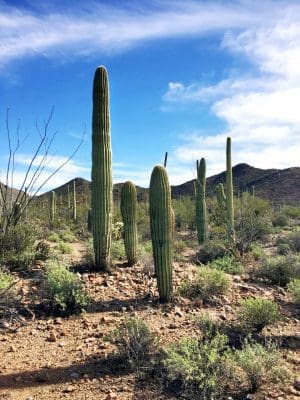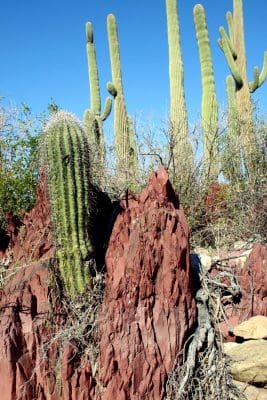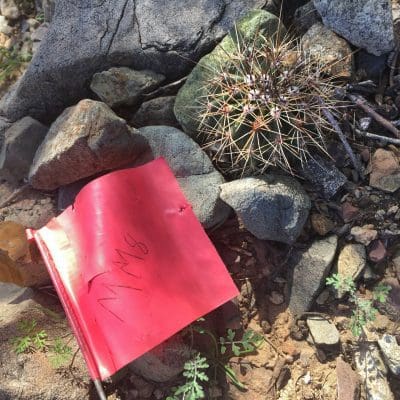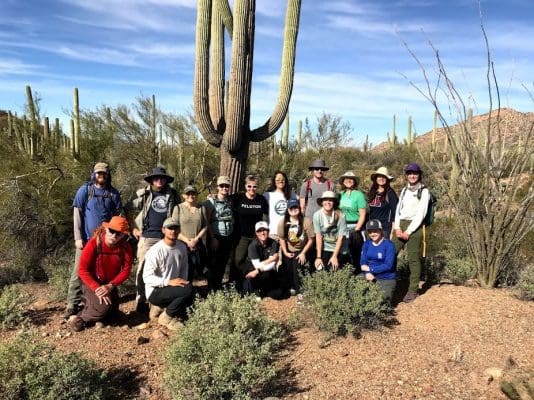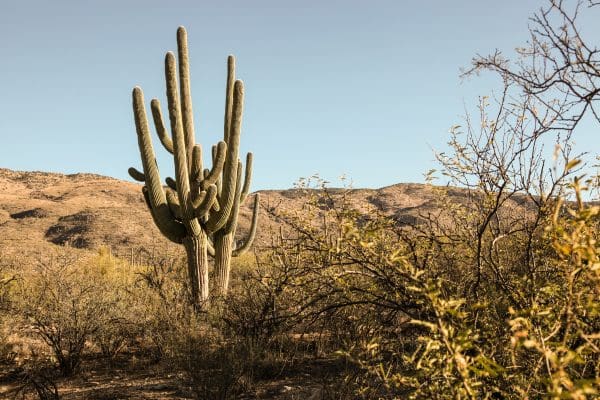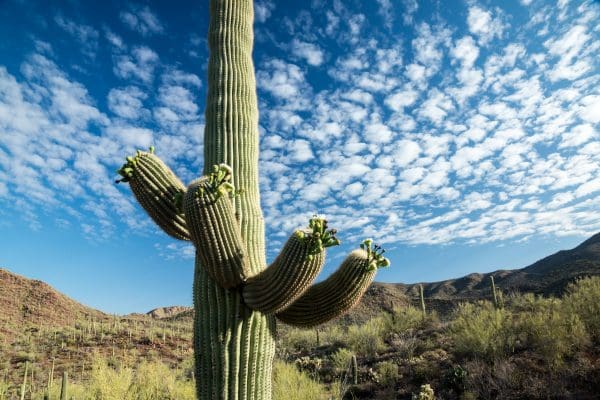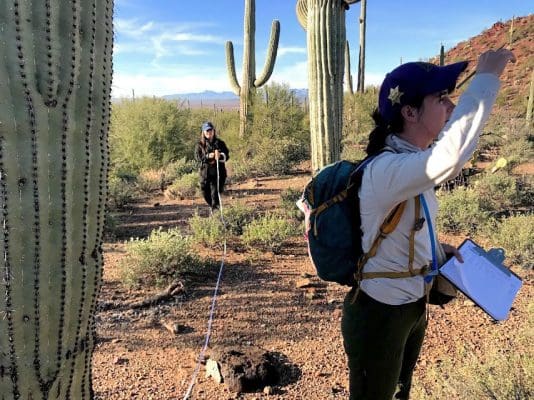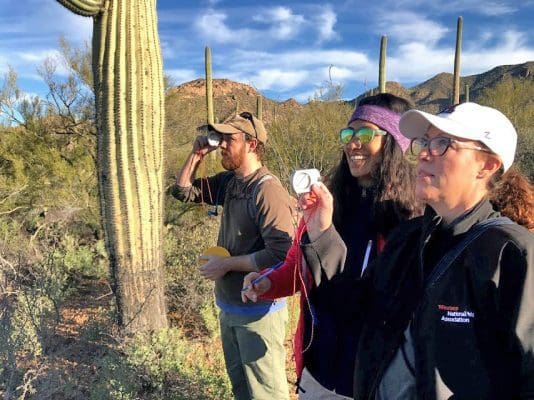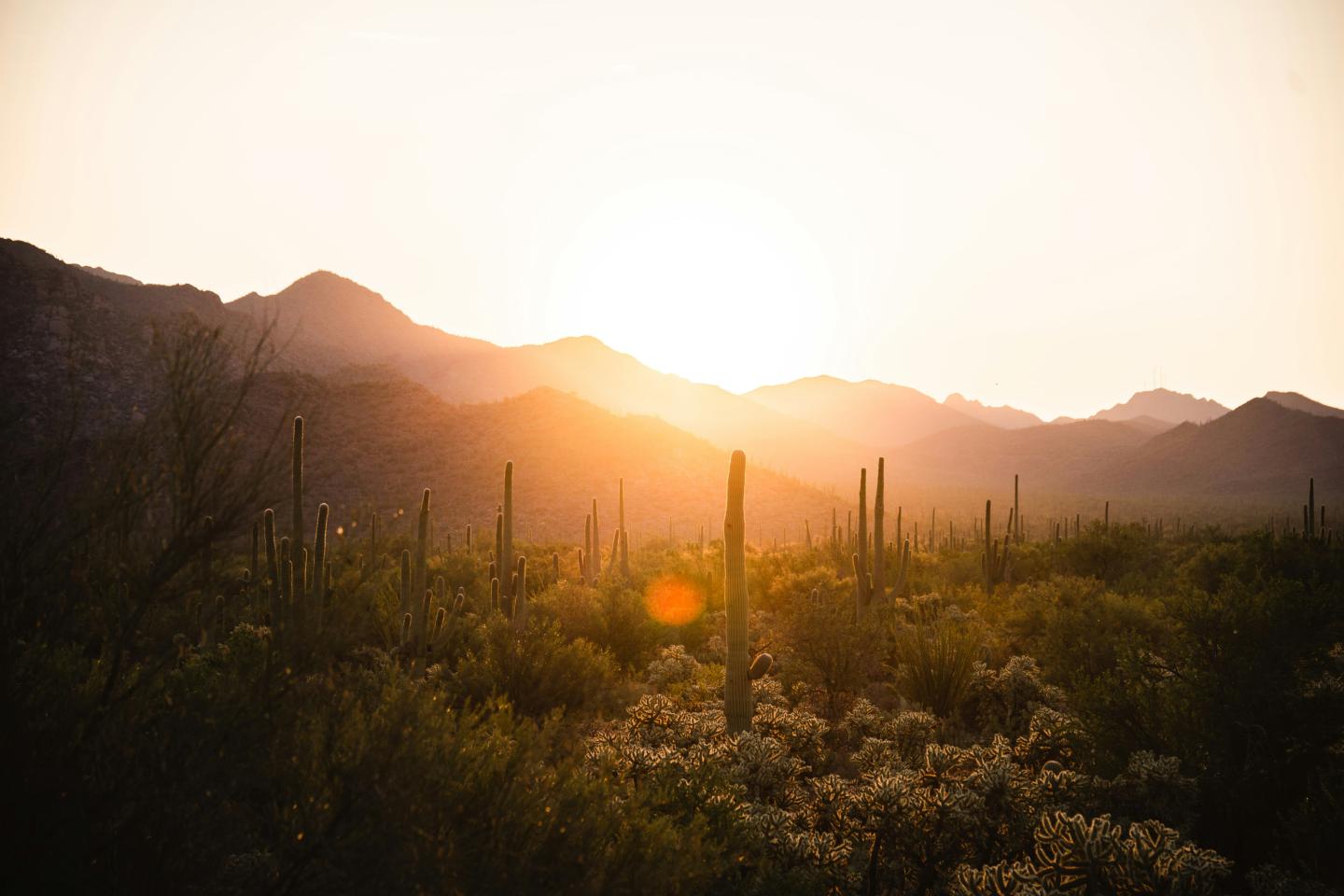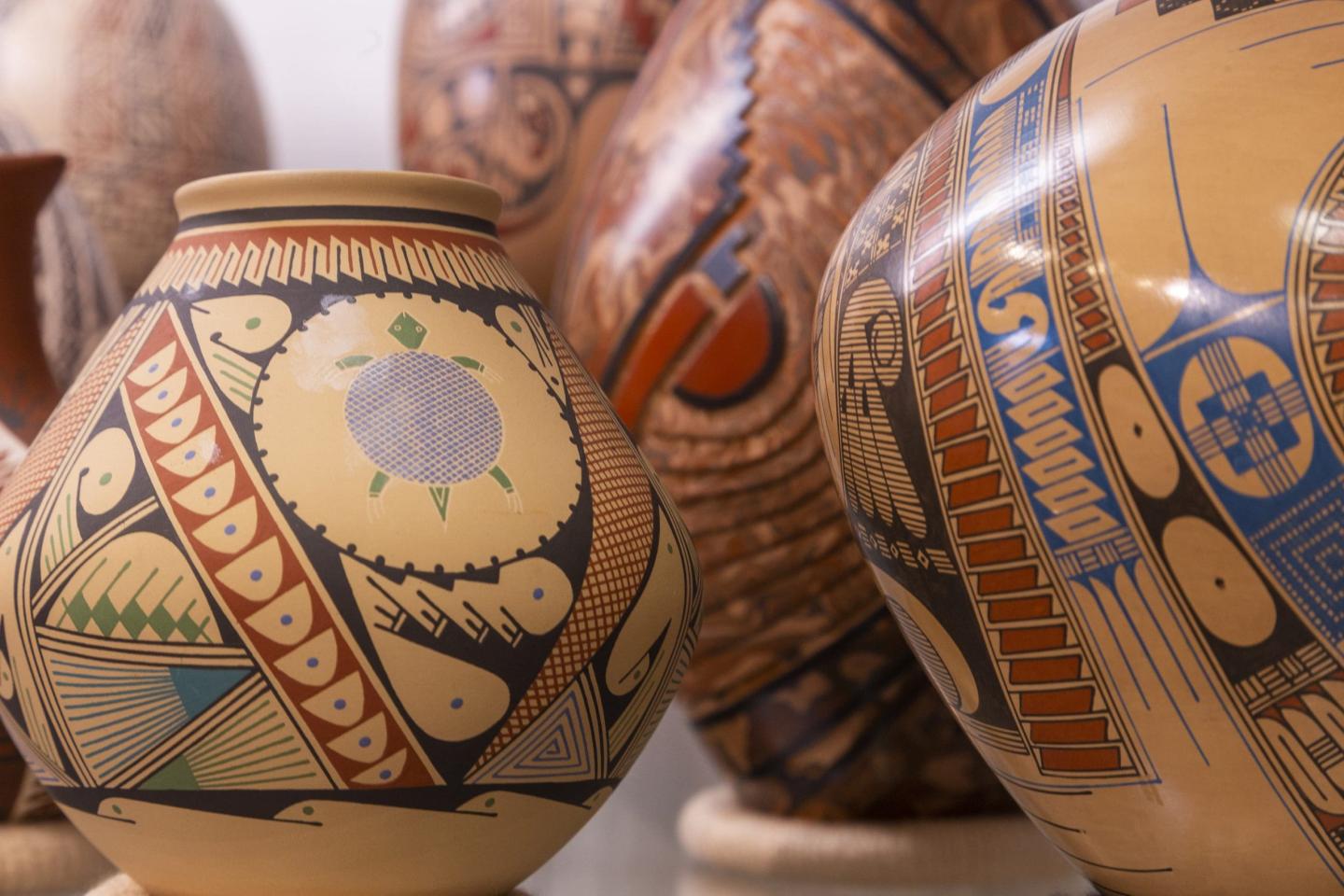
Saguaro Census: Counting on the Future
Long-term research by NPS staff and other scientists suggests that, since the 1990s, a punishing drought has severely hampered the germination of saguaro seeds and growth of young plants into healthy adults.
Looking like a jumbo dill pickle with spines, the small saguaro was barely visible under a shrubby palo verde tree. Maria DelVecchio, WNPA’s senior marketing manager, spotted it and stopped midstride. Squatting beside it for a closer look, she called over her shoulder, “Found a baby.” Her fellow volunteers on the WNPA Saguaro Census team flashed thumbs-up. With Jesús Duenas, a Saguaro National Park intern, leading them,they converged on the small cactus. While one of her teammates wove a numbered pin flag through the spines and another read its Global Positioning System (GPS) coordinates, Maria unfolded a wooden ruler and measured its height. “Ten-point-two centimeters.” Jesús recorded the data on a field form. As the rest of the group moved on, Maria took a minute to estimate the saguaro’s age. Ten-point-two centimeters. Four inches. About 15 years old. She thought about how lucky this little plant was to be alive.
A Saguaro’s Story
This junior saguaro’s story started with one seed in 40 million—the number that an adult may produce in its lifetime. Its parent was a Carnegiea gigantea, one of the enormous elders of the Sonoran Desert that are found nowhere else on Earth and for whose protection Saguaro NP was established. This adult cactus may still be standing tall in another part of the park.
On a July day 15 years ago, perhaps a white-winged dove stuffed itself on the succulent red fruit produced by one of the creamy white flowers that had dotted the parent saguaro’s arms. The dove may eventually have come to rest on a shrubby palo verde tree. It excreted the seeds, some of which fell to the ground. One seed germinated. The tiny plant was given a leg up by its “nurse” tree: shade, protection from predators, a little extra water that gathered in the depression at the tree’s base. For over a dozen years, the young saguaro dodged ecological bullets in the form of thirsty pack rats and mule deer, scorching summers and winter freezes, failed monsoon rains. It survived to become the hidden treasure that Maria and her colleagues recorded on the 2020 NPS Saguaro Census.
Few seeds—or young saguaros—are so fortunate. Long-term research by NPS staff and other scientists suggests that, since the 1990s, a punishing drought has severely hampered the germination of saguaro seeds and the growth of young plants into healthy adults. Because they are growing in a national park, these youngsters are shielded from some threats to which saguaros outside the park succumb. For example, they are protected from cattle grazing and indiscriminate cutting of nurse trees, such as palo verde and mesquite. But they cannot escape the consequences of the long drought and extreme weather events, which may be exacerbated by climate change. Likewise, they are vulnerable to region-wide, human-induced pressures like groundwater pumping in metropolitan Tucson.
To make matters worse, some ecological changes form a tangled net that amplifies the danger for saguaros struggling toward adulthood. For example, buffelgrass—
a large, invasive bunchgrass introduced into the US Southwest as cattle forage—appears to compete directly with young saguaros for space, water, nutrients, and shade. But buffelgrass poses an additional, less direct threat: wildfires. A desert floor covered with buffelgrass is a tinderbox that can explode into rapid, searing flames that destroy saguaros and other native plants. Buffelgrass, on the other hand, bounces back, stronger than ever. To add insult to injury, the establishment of this grass profits from rising ambient temperatures, which also increase the risk of drought and intense fire.
Knowledge is power. To adapt their management practices to these changing conditions on the landscape, NPS staff must know how the saguaro population is responding. Are the adults holding steady in the face of widespread threats? How many young individuals are surviving, and how quickly are they growing? These are the kinds of questions that the Saguaro Census at Saguaro NP was designed to answer.
In 1990, NPS scientists began this census to coincide with the US Census of human populations. A major component of the census is to count and measure saguaros on 45 randomly located plots spread across the park’s two districts: the Rincon Mountain District and the Tucson Mountain District (known to many visitors as “Saguaro East” and “Saguaro West,” respectively). Each plot has an area of 200 by 200 meters. By taking repeated “snapshots” of the number and size of individual saguaros in a particular plot, investigators can compare data on growth and survival within age classes across the years.
From the beginning, park staff knew that they could not accomplish such a massive field effort alone. One of their strategies has been to train and deploy dedicated interns, who work with science advisers and saguaro experts to create the study design and to record data in the census plots. WNPA, among other organizations, has contributed toward funding of the research, especially the participation of interns. In doing so, WNPA has supported perhaps the most important function of interns: the training and oversight of citizen scientists—volunteer teams that are crucial to the success of the census fieldwork.
Park biologist Don Swann, a principal investigator and one of the founders of the Saguaro Census, described the role of these volunteers: “Citizen science greatly expands our capacity to gather basic knowledge and understand changes in the park’s biodiversity. It has the added benefit of giving visitors, students, and others an opportunity to learn about and appreciate these complex ecosystems in a close-up, hands-on way.”
A Citizen Scientist’s Story
The story of a citizen scientist may start with a different kind of seed. When she was a teenager, Maria intended to study biology and was considering becoming a forest ranger. Professional life has taken her elsewhere, but Maria still loves wild places. Every Sunday, she makes a point of hiking in the desert and mountains around her hometown of Tucson.
Maria had been WNPA’s senior marketing manager for less than a month when word spread through the main office in Tucson about a volunteer opportunity at Saguaro NP. Park staff needed a team of citizen scientists to complete the 2020 census of Plot 28, in the Tucson Mountain District. Although WNPA staff had volunteered for other efforts to support the park, they had never before fielded a Saguaro Census team. In short order, like-minded colleagues decided to take up the challenge, and early on a warm, sunny January morning, Maria and 11 teammates headed out to Plot 28.
Once on the ground, interns divided the WNPA team into groups of three to five people. An expert from Saguaro NP accompanied each group, guided their work, and recorded the data that they collected. Maria’s group started walking off-trail along a defined swath of desert, marked with flagging. Whenever they saw a saguaro within the boundary of their swath, they stopped to pin-flag it, record a GPS location, and measure it, as they did for the little 15-year-old that Maria found under the nurse tree. Height measurements were relatively straightforward for the smaller plants—team members could use the folding ruler. But for saguaros taller than 4 meters (about 13 feet), two teammates had to measure height by looking through clinometers and then comparing their results for accuracy. These handheld optical devices measure angles that can then be converted to heights. The technique may sound like simple geometry, but according to one of Maria’s teammates, WNPA publishing manager Sara Maher,
“Using the clinometers took some getting used to, but once we got the hang of it, it was really cool seeing how tall the saguaros actually are.”
For these big saguaros, the team also recorded the number of stems (arms), the number of cavities (many of which were nest holes used by birds), and any visible damage or rot.
After the first pass through each swath of the census plot, the survey groups switched paths to do a second sweep. The focus of this second pass was to find the smaller saguaros that might have been missed on the first trip through. As the day went on, teammates entered into friendly competition. Points were scored for recording the tallest and the smallest. Points were lost for mistaking a hedgehog cactus (which can look very similar) for a young saguaro. Finding the most “babies” was a major goal of the game.
Finally, all the saguaros in Plot 28 were accounted for, and the team made one last pass to collect the pin flags, as well as the flagging that marked the plot boundaries. At the end of six hours in the field, one of Maria’s teammates, graphic designer Brad Sutton, was not tired but energized. For him, the experience was a throwback to his days on staff at Joshua Tree National Park, where he valued time spent in the field with resource experts “I’ll never forget the experience of being a part of the Saguaro Census,” he said. “I’ll always have that special connection to the park.” Maria agreed: “I can never look at a saguaro the same way again.”
Like other groups that have participated in the census, the WNPA team was able to see the results of their efforts soon afterward. The NPS interns and investigators quickly compile the data for each plot and post displays and summaries on the census website, along with photographs of the team members in action. Maria and her teammates learned that they had counted and measured more than 150 saguaros in their section of Plot 28. When their data were combined with those from the survey of the rest of the plot, the total count was 539 saguaros in an area of slightly less than 10 acres. Thirty-three of those individuals were as short as or shorter than Maria’s 15-year-old. Good news—in 1990, only 393 saguaros were counted in Plot 28. Both the higher count and the distribution of young saguaros among age classes in 2020 suggest that these cacti are surviving and growing.
The big-picture results are encouraging, too. Analysis of the data from the 2010 census showed a 65 percent increase, since 1990, in the number of saguaros recorded across all 45 plots in the two districts. Mathematical estimates placed the total population for the park at nearly two million. Don Swann emphasized the value of continuing this research in 2020 and beyond: “We’re concerned about the future of saguaros in the park because, in general, we have seen far fewer young saguaros surviving in the past 25 years than we saw during the period from the 1960s through the early 1990s. However, we’re not alarmed, because saguaros are a long-lived plant, very resistant to drought, and capable of reproducing for over 100 years. Continuing the Saguaro Census will allow us to keep an eye on how the population is doing in the long term.”
For centuries, saguaros have been an integral element of the deep cultural traditions of the Tohono O’odham, whose annual harvest of saguaro fruits continues in Saguaro NP to this day. With the Saguaro Census, citizen scientists of all ages and cultures can be part of a different kind of harvest: the gathering of information that NPS staff could never gather alone. Browse the Saguaro Census 2020 website, and you’ll see high-school-age faces (some serious, some smiling) among the team photos. Like Maria’s little saguaro, these young scientists are a source of hope for the future of Saguaro NP’s beloved giants.
By Jennifer Shopland
var jQ = jQuery.noConflict(); jQ(document).ready(function(){ jQ(window).load(function(){ var mySwiperG = new Swiper ('.swiper-container-gallery', { slidesPerView: 1, spaceBetween: 15, allowTouchMove: true, //freeMode: true, preloadImages: false, lazy: true, autoplay: { delay: 6000, }, scrollbar: { el: '.swiper-scrollbar', hide: false, }, navigation: { nextEl: '.swiper-button-next', prevEl: '.swiper-button-prev', }, breakpoints: { // when window width is >= 640px 578: { slidesPerView: 'auto' } } }); }); });



